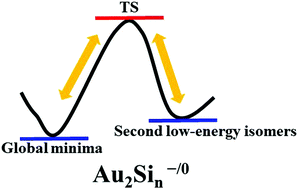Structural evolution from exohedral to endohedral geometries, dynamical fluxionality, and structural forms of medium-sized anionic and neutral Au2Sin (n = 8–20) clusters†
Abstract
The structural evolution of medium-sized anionic and neutral Au2Sin (n = 8–20) clusters is investigated by using density functional theory (DFT) calculations and CCSD(T) methods in combination with the particle swarm optimization (CALYPSO) global search algorithm. The geometries of anionic and neutral Au2Sin clusters change from exohedral to endohedral ones with the increasing cluster sizes, and the critical size of forming Au2-endohedral structures for both anionic and neutral clusters is confirmed to be n = 20, in which a C2h symmetric Au2-endohedral cage-like structure is observed. Anionic and neutral Au2Sin clusters are primarily dominated by prism-based geometries with most of them adopting different structural features. It is found that the two Au atoms prefer to occupy low coordination sites and interact with fewer Si atoms. The Au atoms carry negative charges because of the electron-transfer from Sin frameworks. Meanwhile, the two Au atoms have very weak interactions. The second-order energy differences and incremental binding energies of anionic and neutral Au2Sin clusters exhibit an odd–even alternation and Au2Si20−/0 clusters are proven to have the highest chemical stability among these Au–Si clusters. Interestingly, Au2Si8−, Au2Si9−, Au2Si13−, Au2Si15−, and Au2Si17− anions, along with Au2Si13, Au2Si14, and Au2Si17 neutrals, have multiplicity of structural forms and their low-lying isomers show dynamical fluxionality due to the low barrier energies.

- This article is part of the themed collection: 2020 PCCP HOT Articles


 Please wait while we load your content...
Please wait while we load your content...